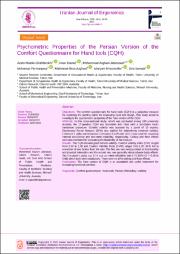| dc.contributor.author | Maleki-Ghahfarokhi, Azam | en_US |
| dc.contributor.author | Dianat, Iman | en_US |
| dc.contributor.author | Asghari Jafarabadi, Mohammad | en_US |
| dc.contributor.author | Parnianpour, Mohamad | en_US |
| dc.contributor.author | Azghani, Mahmood-Reza | en_US |
| dc.contributor.author | Khosravifar, Maryam | en_US |
| dc.contributor.author | Samadi, Sina | en_US |
| dc.date.accessioned | 1401-09-20T20:27:51Z | fa_IR |
| dc.date.accessioned | 2022-12-11T20:27:51Z | |
| dc.date.available | 1401-09-20T20:27:51Z | fa_IR |
| dc.date.available | 2022-12-11T20:27:51Z | |
| dc.date.issued | 2022-07-01 | en_US |
| dc.date.issued | 1401-04-10 | fa_IR |
| dc.identifier.citation | (1401). مجله ارگونومی, 10(1), 26-35. | fa_IR |
| dc.identifier.issn | 1735-1960 | |
| dc.identifier.issn | 2345-5365 | |
| dc.identifier.uri | http://journal.iehfs.ir/article-1-882-en.html | |
| dc.identifier.uri | https://iranjournals.nlai.ir/handle/123456789/934901 | |
| dc.description.abstract | Objectives: The comfort questionnaire for hand tools (CQH) is a subjective measure for exploring the starting points for improving hand tool design. This study aimed to investigate the psychometric properties of the Farsi version of the CQH.
Methods: In this cross-sectional study, which was conducted among 163 university students, the 17-question CQH was translated into Farsi with a translation back-translation procedure. Content validity was assessed by a panel of 10 experts. Exploratory Factor Analysis (EFA) was applied for determining construct validity. Cronbach’s alpha and Intraclass Correlation Coefficient (ICC) were used for assessing internal consistency and test-retest reliability, respectively. Ceiling and floor effects were also estimated for evaluating the feasibility of the measure.
Results: The CQH showed good content validity. Content validity index (CVI) ranged from 0.80 to 1.00 and Content Validity Ratio (CVR) ranged 0.62-1.00. EFA led to extraction of two factors from the data. The first one was mostly related to functionality and physical interaction and the second one, was generally about adverse body effects. The Cronbach’s alpha was 0.74 and test-retest reliability was 0.74 (95% CI = 0.58 to 0.86) which both were satisfactory. There were no (0%) ceiling and floor effects.
Conclusion: The Farsi version of CQH is an acceptable and useful instrument for evaluating hand tools comfort. | en_US |
| dc.format.extent | 966 | |
| dc.format.mimetype | application/pdf | |
| dc.language | English | |
| dc.language.iso | en_US | |
| dc.publisher | انجمن ارگونومی و مهندسی عوامل انسانی ایران | fa_IR |
| dc.relation.ispartof | مجله ارگونومی | fa_IR |
| dc.relation.ispartof | Journal of Ergonomics | en_US |
| dc.subject | Comfort questionnaire | en_US |
| dc.subject | Hand tools | en_US |
| dc.subject | Persian | en_US |
| dc.subject | Reliability | en_US |
| dc.subject | Validity | en_US |
| dc.subject | Other Cases | en_US |
| dc.title | Psychometric Properties of the Persian Version of the Comfort Questionnaire for Hand tools (CQH) | en_US |
| dc.type | Text | en_US |
| dc.type | Research | en_US |
| dc.contributor.department | Student Research Committee, Department of Occupational Health & Ergonomics, Faculty of Health, Tabriz University of Medical Sciences, Tabriz, Iran | en_US |
| dc.contributor.department | Department of Occupational Health & Ergonomics, Faculty of Health, Tabriz University of Medical Sciences, Tabriz, Iran | en_US |
| dc.contributor.department | Cabrini Research, Cabrini Health, VIC 3144, Australia and School of Public Health and Preventative Medicine, Faculty of Medicine, Nursing and Health Sciences, Monash University, Australia | en_US |
| dc.contributor.department | School of Mechanical Engineering, Sharif University of Technology, Tehran, Iran | en_US |
| dc.contributor.department | Faculty of Biomedical Engineering, Sahand University of Technology, Iran | en_US |
| dc.contributor.department | Student Research Committee, Department of Occupational Health & Ergonomics, Faculty of Health, Tabriz University of Medical Sciences, Tabriz, Iran | en_US |
| dc.contributor.department | Student Research Committee, Department of Occupational Health & Ergonomics, Faculty of Health, Tabriz University of Medical Sciences, Tabriz, Iran | en_US |
| dc.citation.volume | 10 | |
| dc.citation.issue | 1 | |
| dc.citation.spage | 26 | |
| dc.citation.epage | 35 | |





